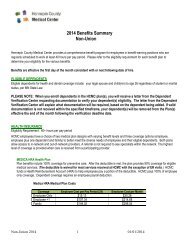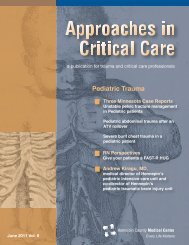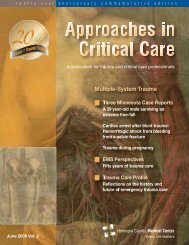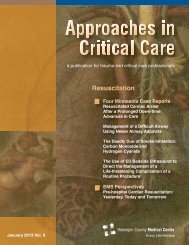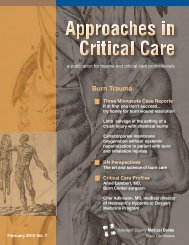Ischemic Stroke - Hennepin County Medical Center
Ischemic Stroke - Hennepin County Medical Center
Ischemic Stroke - Hennepin County Medical Center
You also want an ePaper? Increase the reach of your titles
YUMPU automatically turns print PDFs into web optimized ePapers that Google loves.
Case Reports<br />
Since this patient suffered a relatively small<br />
area of already infarcted brain prior to the procedure,<br />
his risk of suffering a hemorrhage was<br />
probably significantly lower than one might<br />
predict based on the treatment time window.<br />
Figure One. On left, occlusion of left MCA. On right, reperfusion after IAT.<br />
received IAT within 6 hours of MCA stroke<br />
symptom onset with a control group that<br />
received IV heparin. IAT succeeded in arterial<br />
recanalization of 67% of patients vs. 18% in<br />
the control group.<br />
The possible side effect of intracerebral hemorrhage<br />
(ICH) remains a concern. In this<br />
PROACT II study, there was an increase in<br />
symptomatic ICH (10.2% vs. 1.8% at 24<br />
hours), although there was no significant difference<br />
in 90-day survival. Less data are available<br />
comparing IAT to IVT. Further studies of<br />
IAT for MCA ischemic stroke are needed<br />
before approval of this treatment by the FDA.<br />
In this case, the patient presented after the traditionally<br />
accepted window for both IVT and<br />
IAT. There is limited research on delayed IAT<br />
administration, but recent data suggest that<br />
IAT administration based on imaging and<br />
symptoms can extend the accepted treatment<br />
window. One study of intra-arterial urokinase<br />
administered within 3.5 to 48 hours of symptom<br />
onset in 13 patients showed symptom<br />
improvement in 69% of patients at 48 hours<br />
and 100% of surviving patients at 3 months.<br />
This patient may have been considered a good<br />
candidate for delayed IAT because he was<br />
young, otherwise healthy with few co-morbidities,<br />
and had a CT perfusion scan and MRI<br />
scan that showed only a small existing infarction<br />
with a very large perfusion deficit (i.e.<br />
large ischemic penumbra.) New data also suggest<br />
that the risk of symptomatic intracerebral<br />
hemorrhage related to thrombolysis correlates<br />
with the size of the infarction prior to treatment.<br />
Suggested Readings/Bibliographies for Case Reports<br />
Adams HP, et al. Guidelines for the early management of<br />
adults with ischemic stroke. <strong>Stroke</strong>. 2007; 38:1655-1711.<br />
Barnwell SL, et al. Safety and efficacy of delayed intra-arterial<br />
urokinase therapy with mechanical clot disruption for thromboembolic<br />
stroke. Am J of Neuroradiol. September 2004;<br />
25:1391-1402.<br />
Ciccone A, et al. Debunking 7 myths that hamper the realization<br />
of randomized controlled trials on intra-arterial thrombolysis<br />
for acute ischemic stroke. <strong>Stroke</strong>. Jul 2007; 38: 2191-2195.<br />
Del Zoppo GJ, Higashida RT, et al. PROACT: A Phase II randomized<br />
trial of recombinant pro-urokinase by direct arterial<br />
delivery in acute middle cerebral artery stroke. <strong>Stroke</strong>. 1998;<br />
29:4-11.<br />
Furlan R, Higashida A. Intra-arterial prourokinase for acute<br />
ischemic stroke. A PROACT II study: a randomized controlled<br />
trial. JAMA. 1999; 282:2003-2011.<br />
Lansberg MG, Thijs VN, Bammer R et al. Risk factors of<br />
symptomatic intracerebral hemorrhage after tPA therapy for<br />
acute stroke. <strong>Stroke</strong>: A Journal of Cerebral Circulation.<br />
2007;38:2275-2278.<br />
Marx, J; Hockberger, R; Walls, R. Rosen's Emergency Medicine:<br />
Concepts and Clinical Practice. 6th Ed. Elsevier. 2005.<br />
Martel, N; Lee, J; Wells, PS. Risk for heparin-induced thrombocytopenia<br />
with unfractionated and low-molecular-weight<br />
heparin thromboprophylaxis: A meta-analysis. Blood 2005;<br />
106:2710.<br />
Napolitano, LM, et al. Heparin-induced thrombocytopenia in<br />
the critical care setting: Diagnosis and management. Crit Care<br />
Med 2006; 34:2898.<br />
Procaccio, F, et al. Guidelines for the treatment of adults with<br />
severe head trauma (part I). Initial assessment; evaluation and<br />
pre-hospital treatment; current criteria for hospital admission;<br />
systemic and cerebral monitoring. J Neurosurg Sci March<br />
2000; 44(1):1-10.<br />
Procaccio, F; Stocchetti, N; Citerio, G; et al. Guidelines for the<br />
treatment of adults with severe head trauma (part II). Criteria<br />
for medical treatment. J Neurosurg Sci March 2000; 44(1):11-18.<br />
Warkentin, TE; Levine MN; Hirsh, J. Heparin-induced thrombocytopenia<br />
in patients treated with low-molecular-weight<br />
heparin or unfractionated heparin. N Engl J Med 1995;<br />
332(20):1330-1336.<br />
Zeumer H, Hacke W, Ringelstein EB. Intra-arterial thrombolysis.<br />
Am. J. Neuroradiol., September 1, 2001; 22:18S - 21S.<br />
10 | Approaches in Critical Care | December 2008





